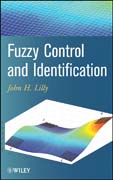
A fuzzy control system is a control system based on fuzzy logic, which is a mathematical system that analyzes analog input values in terms of logical variables that take on continuous values between 0 and 1. This text provides a broad introduction to fuzzy control and identification, covering both Mamdani and Takagi-Sugeno fuzzy systems. The text shows how these can be used to control complex nonlinear engineering systems, while also also suggesting several approaches to modeling of complex engineering systems with unknown models. It is useful in any engineering department, at first-year graduate level. INDICE: Preface. Ch 1 Introduction. 1.1 Fuzzy systems. 1.2 Expert knowledge. 1.3 When and when not to use fuzzy control. 1.4 Control. 1.5 Interconnection of several subsystems. 1.6 Identification and adaptive control. 1.7 Summary.Exercises. Ch 2 Basic Concepts of Fuzzy Sets. 2.1 Fuzzy sets. 2.2 Useful concepts for fuzzy sets. 2.3 Some set theoretic and logical operations on fuzzy sets. 2.4 Example. 2.5 Singleton fuzzy sets. 2.6 Summary. Exercises. Ch 3 Mamdani Fuzzy Systems. 3.1 If-then rules and rule base. 3.2 Fuzzy systems. 3.3 Fuzzification. 3.4 Inference. 3.5 Defuzzification. 3.6 Example fuzzy system for windchill. 3.7 Summary. Exercises. Ch 4 Fuzzy Control with Mamdani Systems. 4.1 Tracking control with a Mamdani fuzzy cascade compensator. 4.2 Tuning for improved performance by adjusting scaling gains. 4.3 Effect of input membership function shapes. 4.4 Conversion of PID controllers into fuzzy controllers. 4.5 Incremental fuzzy control. 4.6 Summary. Exercises. Ch 5 Modeling and Control Methods Useful for Fuzzy Control. 5.1 Continuous-time model forms. 5.2 Model forms for discrete-time systems. 5.2.1 Input-output difference equation model for discrete time systems. 5.3 Some conventional control methods useful in fuzzy control. 5.4 Summary. Exercises. Ch 6 Takagi-Sugeno Fuzzy Systems. 6.1 T-S fuzzy systems as interpolators between memoryless functions. 6.2 T-S fuzzy systemsas interpolators between continuous-time linear state-space dynamic systems. 6.3 T-S fuzzy systems as interpolators between discrete-time linear state-space dynamic systems. 6.4 T-S fuzzy systems as interpolators between discrete-time dynamic systems described by input-output difference equations. 6.5 Summary.Exercises. Ch 7 Parallel Distributed Control with T-S Fuzzy Systems. 7.1 Continuous-time systems. 7.2 Discrete-time systems. 7.3 Parallel distributed tracking control. 7.4 Parallel distributed model reference control. 7.5 Summary. Exercises. Ch 8 Estimation of Static Nonlinear Functions from Data. 8.1 Least squares estimation. 8.2 Batch least squares fuzzy estimation in Mamdani form. 8.3 Recursive least squares fuzzy estimation in Mamdani form. 8.4 Least squares fuzzy estimation in Takagi-Sugeno form. 8.5 Gradient fuzzy estimation in Mamdani form. 8.6 Gradient fuzzy estimation in Takagi-Sugeno form. 8.7 Summary. Exercises. Ch 9 Modeling of Dynamic Plants as Fuzzy Systems. 9.1 Modeling known plants as T-S fuzzy systems. 9.2 Identification in input-output difference equation form. 9.3 Identification in companion form. 9.4 Summary. Exercises. Ch. 10 Adaptive Fuzzy Control. 10.1 Direct adaptive fuzzy tracking control. 10.2 Direct adaptive fuzzy model reference control. 10.3 Indirect adaptive fuzzy tracking control. 10.4 Indirect adaptive fuzzy model reference control. 10.5 Adaptive feedback linearization control. 10.6 Summary. Exercises. References. Appendix Computer Programs.
- ISBN: 978-0-470-54277-4
- Editorial: John Wiley & Sons
- Encuadernacion: Cartoné
- Páginas: 264
- Fecha Publicación: 01/10/2010
- Nº Volúmenes: 1
- Idioma: Inglés
